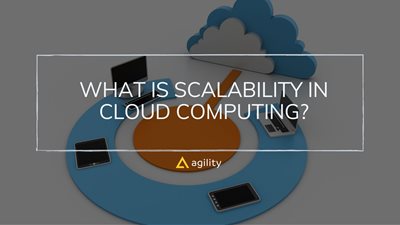What Is Scalability in Cloud Computing?

As companies decide to use the cloud rather than on-premises systems, one of the principal advantages of migration to the cloud is scalability, meaning your company can scale quickly and rapidly. But what does this mean? Let’s consider various kinds of scalability in cloud computing and what they can point to a company.
What Is Cloud Computing All About?
Cloud computing provides resources and services to businesses with a particular emphasis on processing power and data storage. These are provided on a pay-as-you-use basis over the internet. The principal characteristics of cloud-based systems include:
- Automation
- Combining of Resources
- Easy maintenance
- Economical
- Monitoring and reporting
- Network access
- Resource pooling
- Scalability
- Data Security
- Self-service
What Are Clouds?
Hybrid cloud
This is a cloud system that mixes a private and a public cloud.
Multi-cloud
A multi-cloud combines the services of several cloud vendors.
Private cloud
Private clouds are not publicly available. They are used by a single entity.
Public cloud
Offered by third-party vendors, anyone can utilize public clouds.
Service Types
Cloud services are delivered in three fundamental ways:
- IaaS – Infrastructure-as-a-Service. This is the most flexible cloud service available. It provides an entirely virtual computing infrastructure.
- PaaS – Platform-as-a-Service. This is less specialized but offers more than just infrastructure.
- SaaS – Software-as-a-Service. This kind of service is a complete software offering purchased through a subscription.
What Is Scalability in Cloud Computing?
Scalability refers to the option of increasing or decreasing IT capabilities and resources. Scalability allows companies to scale storage capacity, networking possibilities, and even computing power in accordance with specific company needs at any given time.
As a company’s needs change, scalability permits modifications without disrupting business activities and services. What’s more, modifications are not permanent; you can continue adjusting or return to original configurations at any time.
Cloud computing can be accomplished rapidly and without difficulty thanks to cloud vendors that already operate pre-existing infrastructures. Unlike on-premises solutions that can take weeks or months to modify, scalability is a tool that allows for faster adjustments.
Scalability Types Available in Cloud Computing
There are two principal types of scalability in cloud computing: vertical and horizontal. Which type is better for your company depends on the business’s specific operational needs and current and future business needs, so let’s consider the differences between the two types of scalability available.
Vertical Scaling
Vertical scaling means the capability to scale up or down. This refers to adding or diminishing the existing power capabilities to improve storage capabilities, memory capacities, and processing workloads. It can influence performance or reduce downtime, but it optimizes company resources. When properly used, your cloud costs can decrease.
Pros:
Permits right sizing rather than purchasing more cloud resources. It can help reduce costs.
Cons:
Vertical scaling can be more expensive, and it may require some downtime.
Horizontal Scaling
Horizontal scaling implies removing or adding extra servers to a company’s cloud infrastructure. By dividing computing traffic between two instances or more, computing loads will be divided among more machines. This means that service can be enhanced. Horizontal scaling can be applied automatically and without causing your company downtime. With the addition of more instances, companies may enjoy better functioning despite a significant technical failure or even a natural disaster.
Pros:
Horizontal scaling requires little or no downtime. It is easier to manage automatically.
Cons:
Costs can run higher depending on how many instances your company requires.
Horizontal vs. Vertical Scaling
The choice of vertical scaling entails adding resources to an infrastructure that already exists. This, however, will not improve performance. Horizontal scaling goes where vertical scaling stops short by adding nodes to pre-existing infrastructure. The addition of these nodes allows for an increased workload and consequently increased performance.
Other Scalability Options
HA – High Availability
High availability means a system will be available 99.99% of the time. This generally involves a failover system that can intervene and manage workloads like the primary system.
FT – Fault Tolerant
The Fault Tolerant system is a better version of the HA system. It guarantees there will be zero downtime for your system.
DR – Disaster Recovery
Disaster Recovery goes a step further than HA and FT as it offers the possibility to recover all critical business systems in inclement weather or a natural disaster.
Automatic Scaling
Auto-scaling is when computing, storage, and databases scale according to predefined rules. This means that your application is always available.
Manual Scaling
Scaling manually will require an engineer to scale up, down, in, or out. It will not take into account fluctuations. It can be relatively easy to manage, but should you forget to scale down; it can lead to higher costs.
Scheduled Scaling
Scaling can be based on when your company’s peak activity takes place.
What’s Diagonal Scaling? How Does It Differ from Vertical and Horizontal Scaling?
Diagonal scalability is a combination of vertical and horizontal scaling that permits the removal of resources from servers already in place, whereas vertical and horizontal scalability permit only the addition of resources and the increase of capacities. Horizontal and Vertical scaling does not permit storage removal should your business needs decrease.
Why Is Cloud Computing Scalable?
Virtual machines and the virtualization of processes make the architecture of the cloud scalable. A characteristic of virtualization is flexibility. Physical machines and structures feature set resources and consequentially set performance. Virtual cloud machines can be transferred to other servers or used on multiple servers simultaneously. This allows for increased workloads and applications to be moved to larger virtual machines should the need arise.
Cloud-based service providers are the key to permitting rapid scaling to companies thanks to their software and hardware capabilities which are vital to expansion. What would prove to be highly costly and time-consuming if created as a physical structure becomes self-implemented with the flexibility of the cloud?
What Are the Benefits to Cloud Scalability?
Flexible companies are those that remain 100% operational even in the event of a sudden increase in demand. Scalability can prove not only to be efficient in a myriad of situations but cost-effective as well. This is only possible with cloud computing services.
Before the development of cloud computing, creating physical architecture for varying organizational needs, especially during periods of expansion, can be too costly to be soluble. The elasticity of cloud computing makes its cost-effectiveness one of its most significant advantages.
Consider these aspects:
Convenience
Cloud scalability can provide maximum convenience in that it can tailor and customize cloud computing to the precise organizational needs of a company.
Cost Effectiveness
One great advantage to scalability is that it allows companies to pay only for their use. They don’t need to buy expensive equipment that will become obsolete in a very brief time.
Data Recovery
Extra data centers become unnecessary thanks to scalability. This will also save on personnel and costs for servicing additional centers.
Flexibility
Cloud computing scalability offers the possibility to accommodate changing needs and a surge in growth. It also eliminates the need to replace obsolete equipment and allows work to be streamlined.
Power
Cloud computing allows access to lots of power and high-powered resources and data tools and cutting-edge software. In the past, physical infrastructures were limited and did not allow rapid scaling. Businesses were required to purchase expensive equipment and needed money and time to implement expansions and upgrades.
Speed
Often a quick response is everything for a business to remain successful. Cloud scalability equips companies with high-powered tools and response rapidity.
Storage
Scalable storage on cloud systems is a powerful tool, especially for companies that experience growth. Scaling will allow businesses to tailor their cloud storage to company needs. Physical structures are no more.
What’s the Difference Between Cloud Scalability and Cloud Elasticity? Is One Preferable to the Other?
While these two concepts may seem the same, scalability and elasticity are not precisely the same, elasticity refers to how a company uses actual resources. In contrast, scalability responds to the needs of increasing workloads without changing the existing infrastructure.
Scalability reflects the design of a computing solution, while elasticity can be more accurately described as an action.
Elasticity is an appropriate choice for known variables in workload requirements, while business growth increases will determine the need for scalability in cloud computing.
Cloud service vendors can offer both solutions. A flexible system will be able to adjust automatically to real-time needs with available resources. This is an excellent solution for companies with variable and unpredictable workloads. Elasticity answers immediate but variable spikes.
Scalability refers to adding or diminishing resources to respond to changes in demand. It allows for consistent long-term growth. Scalable cloud computing will continue operations even during pressure moments and can aid in removing bugs, updating programs, and monitoring activity.
Both alternatives are crucial as potential business solutions. It’s essential when deciding to evaluate if your internet and website activities are predictable or purely random. Consider that cloud elasticity is more common in public clouds while cloud scalability is more often found in private clouds.
When Should a Company Use Cloud Scalability?
Cloud scalability implies scaling cloud computing specifically to a business’s needs. It is the driving force behind migration to the cloud. As companies grow, and require an increase in resources, scalability facilitates speedy responses that are cost-effective.
How Does a Company Achieve Cloud Scalability?
Virtualization is the key to scalability. Physical machines and structures have limits whereas virtual machines are flexible allowing easily for scalability. Virtual machines can be moved to different servers or hosted on multiple servers as an alternative. Company computing can also be easily upgraded to bigger virtual machines.
A company’s scalability will depend on the cloud type your company selects. Public cloud vendors have large amounts of resources which permit rapid and budget-friendly scaling. Private or hybrid clouds offer scaled, customized systems.
Methods for scaling cloud-based computing include:
- Requesting it from your cloud provider.
- Going through an online portal and acquiring resources.
Some options will offer auto-scaling meaning you can set them to scale up or down based on your input. You can set your system to scale up automatically when you begin to exhaust storage space.
What Best Practices Should I Keep in Mind for Cloud Scalability?
Business needs will inevitably change to some degree over time. Consider"
Continued Testing
Performance testing is vital to getting the most value for your investment. This will enable business scaling choices. Your IT department needs to evaluate performance aspects like memory usage, CPU load, and response time.
Auto-scaling Capabilities
Automation processes can enable and optimize a company’s cloud scalability. The use of automatic rules when your business computing reaches specific limits so that company performance is not negatively impacted.
Cloud Computing Scalability’s Key Features
Some of the principal features of cloud scalability include:
Increasing or decreasing
Scaling involves sizable changes, not minor modifications. As your business changes in size, you may need to increase or decrease needs.
Velocity
Cloud computing scaling is rapid. It is much faster than upgrading physical hardware.
Ease of Operation
Cloud solutions are easy to scale while physical machines are expensive and time-consuming.
No Business Disruption
Scaling does not mean you are replacing systems, just adding or decreasing resources. This means any downtime will be kept to a minimum.
In Conclusion
Technology can and will make or break your business and selecting the correct technology for your business becomes vital to your company’s future. As more and more businesses migrate to cloud computing, scalability is a fundamental tool in getting the most out of cloud computing. It is not synonymous with business growth but rather with meeting demand. It can be a key to business growth, by helping companies remain competitive.
How a company achieves scalability will depend on the choice of cloud model. Each model brings with it a variety of advantages from exceptional business flexibility to saving on operational costs.
To get the best value for your investment, it’s important to determine which is the best kind of scaling for business needs.



